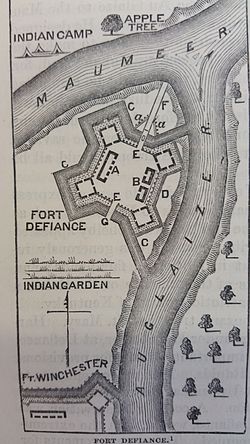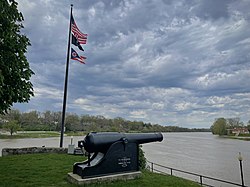
| Fort Defiance | |
|---|---|
| Part of the Northwest Territory of the United States | |
| present day Defiance, Ohio | |
 Fort Defiance[1] | |
| Site history | |
| Built | 1794 |
| Battles/wars | Northwest Indian War, Tecumseh's War, War of 1812 |
| Garrison information | |
| Past commanders | Anthony Wayne |
| Occupants | United States troops |
Fort Defiance Park | |
 | |
| Location | Fort St., Defiance, Ohio |
|---|---|
| Coordinates | 41°17′15″N 84°21′25″W / 41.28750°N 84.35694°W |
| Area | 1.3 acres (0.53 ha) |
| Built | 1794 |
| Architect | Major Henry Burbeck |
| NRHP reference No. | 80002989[2] |
| Added to NRHP | June 23, 1980 |
Fort Defiance was built by General "Mad" Anthony Wayne in the second week of August 1794 at the confluence of the Auglaize and Maumee rivers. It was one of a line of defenses constructed by American forces in the campaign leading to the Northwest Indian War's Battle of Fallen Timbers on August 20, 1794.[3]
Work began on August 9, 1794, and was completed by August 17. The name was derived from a declaration by Charles Scott, who was leading a band of Kentucky militiamen in support of Wayne, that: "I defy the English, Indians, and all the devils of hell to take it."[4] The post was considered one of the strongest fortifications built in that period.
Before and during the Battle of Fallen Timbers, Wayne ordered the destruction of all Native American villages and their crops within a 50-mile (80 km) radius of the fort. The land which originally belonged to Native Americans was ceded to the United States by the British after the American Revolutionary War. The British would later supply and influence local tribes to take up arms..[5] Under terms of the Treaty of Greenville, signed on August 3, 1795, the native nations ceded six square miles around the fort and allowed the Americans to maintain a trading post there, even though it was within the area of land defined by the "Greenville Treaty Line", beyond which Americans had agreed not to settle. Wayne promised the land of "Indiana", the remaining land to the west, to remain Indian forever. During the treaty meeting, Wayne brought with him food supplies for the natives and made sure crops were planted again.[6] The fort was abandoned in 1796.
Fort Winchester was constructed on a nearby site in 1812 by Gen. William Henry Harrison.
The city of Defiance, Ohio, was founded at the fort's location in 1822. In 1904, the site of the fort was chosen for the Defiance Public Library.
Fort Defiance served as a reference point for defining the boundary line of land cession in the Treaty of Detroit in 1807. This north–south line would be used again as the Michigan Meridian in the survey of lands in Michigan.
Today, a park occupies the site of the fort, which was added to the National Register of Historic Places in 1980.[2]
- ^ Lossing, Benson (1868). The Pictorial Field-Book of the War of 1812. Harper & Brothers, Publishers. p. 330.
- ^ a b "National Register Information System". National Register of Historic Places. National Park Service. March 13, 2009.
- ^ "Fort Defiance". fortdefiance.joshuacatalano.org. Retrieved 2021-08-23.
- ^ Nelson, p. 246
- ^ "Roles of Native Americans during the Revolution". American Battlefield Trust. January 21, 2021.
- ^ September 2019, HistoryNet Staff (2019-07-10). "Book Review: Unlikely General". HistoryNet. Retrieved 2021-10-13.
{{cite web}}: CS1 maint: numeric names: authors list (link)


